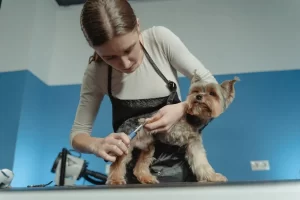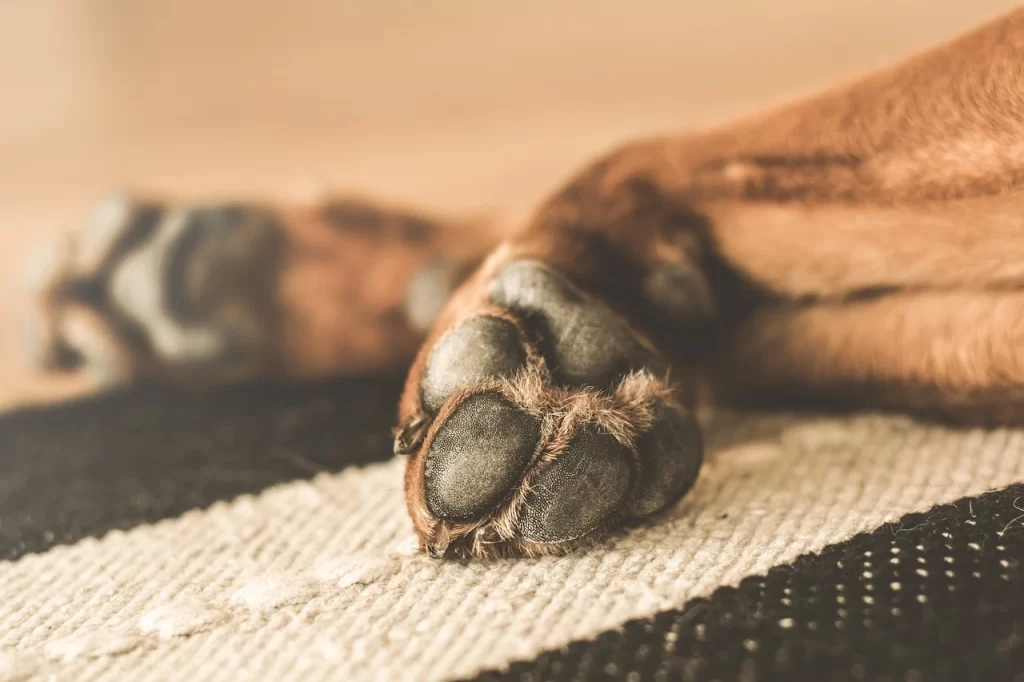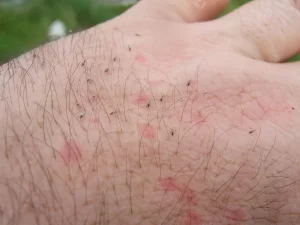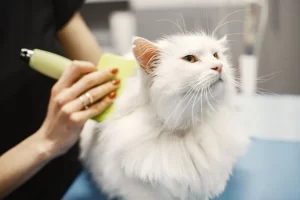Pododermatitis, also known as “bacterial paw infection,” is a common condition that affects many animals, including cats, dogs, rabbits, and guinea pigs. It is characterized by inflammation and infection of the paws, which can cause pain, and discomfort, and even lead to more serious complications if left untreated. While veterinary care is often necessary to properly diagnose and treat pododermatitis, there are also many pododermatitis treatments that can be administered at home to help ease symptoms and promote healing. In this article, we will explore some of the most effective pododermatitis treatments at home, as well as provide helpful tips and insights for preventing and managing this condition in your furry companion.
Table of Contents
ToggleCauses of pododermatitis
Pododermatitis, also known as bumblefoot, is characterized by inflammation and infection of the soft tissues of the foot, including the skin, muscle, and bone. If left untreated, it can progress to a more severe and potentially life-threatening condition.
There are several factors that can cause pododermatitis, including:
- Pressure: Prolonged pressure on the foot, often due to standing or perching on hard or rough surfaces, can cause damage to the soft tissues and lead to the development of pododermatitis.
- Trauma: Injuries to the foot, such as cuts, scrapes, or puncture wounds, can also lead to pododermatitis.
- Bacterial infections: Bacteria, such as Staphylococcus or E. coli, can infect the foot and cause inflammation.
- Fungal infections: Fungi, such as Aspergillus or Candida, can also infect the foot and cause inflammation.
- Nutritional deficiencies: Poor nutrition, specifically a lack of vitamin A, can weaken the immune system and increase the risk of infection and inflammation.
- Obesity: Excess weight can put additional pressure on the feet, leading to inflammation and injury.
- Genetics: Some animals may be more prone to developing pododermatitis due to genetic factors.
- Environmental factors: Dirty or wet living conditions can increase the risk of infection and inflammation in the feet.
Symptoms of pododermatitis
Pododermatitis can affect a variety of animals including cats and dogs. Here are some ways to identify the condition of these animals:
- Lameness or limping: One of the most common signs of pododermatitis is lameness or limping, which can be caused by pain and inflammation in the affected foot.
- Swelling: Pododermatitis can cause swelling of the affected foot, which can be visible or palpable (able to be felt). In severe cases, the swelling may be extensive and cause deformity of the foot.
- Discoloration: The skin of the affected foot may appear reddish, brownish, or blackish, which is due to inflammation and injury.
- Lesions or scabs: Lesions or scabs may be visible on the surface of the skin, and can be caused by bacterial or fungal infections.
- Heat: The affected foot may feel warmer to the touch than the unaffected foot. This is due to the inflammation caused by the infection.
- Pain and discomfort: The animal may exhibit signs of pain and discomfort when the affected foot is touched or manipulated.
Note that some animals, particularly cats, may not show obvious signs of pain or discomfort despite having pododermatitis. In these cases, it may be necessary to seek veterinary care to perform a physical examination and diagnostic tests to confirm the diagnosis. Read more about our guide on how often should I take my dog to the vet?
Treating Pododermatitis: The importance of acting fast
It is important to treat pododermatitis as soon as possible to prevent it from progressing and causing more severe complications. If left untreated, pododermatitis can lead to the following complications:
- Abscesses: Bacterial infections can form abscesses or pockets of pus in the affected foot, which can cause pain and lead to further tissue damage.
- Bone infections: If the infection spreads to the bone, it can cause osteomyelitis or bone infection, which can be difficult to treat and may require long-term antibiotic therapy or even surgery.
- Septicemia: In severe cases, the infection can spread to the bloodstream, causing septicemia or blood poisoning, which can be life-threatening.
- Chronic pain: Chronic inflammation and damage to the tissues of the foot can lead to chronic pain and discomfort for the animal.
- Limping or lameness: Pododermatitis can cause the animal to develop a limp or become lame, which can affect their mobility and quality of life.
- Decreased appetite: Animals may experience decreased appetite and weight loss as a result of pain and discomfort caused by pododermatitis.
- Increased risk of secondary infections: Animals with pododermatitis may be at increased risk of developing secondary infections, as their immune system is weakened by the primary infection.
Seek veterinary care if you suspect your pet has pododermatitis to prevent these complications from occurring. Early treatment can help alleviate symptoms, prevent the infection from spreading, and improve the animal’s overall quality of life.
Pododermatitis risk factors
There are several risk factors that can increase an animal’s likelihood of developing pododermatitis, including:
- Excess weight: Overweight or obese animals are at higher risk of developing pododermatitis due to the increased pressure on their feet.
- Poor nutrition: Animals that do not receive a balanced diet, specifically one that is low in vitamin A, are more prone to developing pododermatitis.
- Genetics: Certain breeds of animals may be more prone to developing pododermatitis due to genetic factors.
- Age: Older animals may be more susceptible to pododermatitis due to decreased mobility and weakened immune systems.
- Immune system disorders: Animals with weakened immune systems, such as those with cancer or HIV, may be more susceptible to developing pododermatitis.
- Dirty or wet living conditions: Animals that live in dirty or wet conditions, such as those in crowded or unsanitary enclosures, are at increased risk of developing pododermatitis due to the increased risk of bacterial or fungal infections.
- Trauma: Animals that experience trauma to their feet, such as cuts, scrapes, or puncture wounds, are at higher risk of developing pododermatitis.
Certain animals may be more prone to developing pododermatitis, including:
- Birds: Pododermatitis is a common condition in birds, particularly those kept in captivity.
- Rodents: Rodents, such as guinea pigs and rats, are also prone to developing pododermatitis, especially if they are housed in inappropriate environments.
- Dogs and cats: While pododermatitis is less common in dogs and cats compared to birds and rodents, it can still occur, especially in animals with preexisting medical conditions or those that are overweight.
Different stages of pododermatitis
Pododermatitis is a progressive condition that can worsen over time if left untreated. There are four different stages of pododermatitis, each with its own set of symptoms and treatment options.
- Stage 1: In the early stage of pododermatitis, the skin on the affected foot may appear red, inflamed, and slightly swollen. The animal may show signs of mild discomfort or limping, and there may be slight hair loss or scaling of the skin. At this stage, the condition is usually treatable with home remedies such as cleaning the foot, applying topical treatments, and changing the animal’s bedding or environment.
- Stage 2: In stage 2, the condition has progressed, and the skin may be ulcerated or broken. The animal may show signs of more severe pain, and there may be moderate hair loss or scaling of the skin. The animal may develop abscesses or secondary bacterial infections. At this stage, treatment may require antibiotics, pain management, and more aggressive cleaning of the foot.
- Stage 3: In stage 3, the condition is severe, and the skin on the affected foot may be severely ulcerated, infected, or even necrotic. The animal may show signs of significant pain, and there may be significant hair loss or scaling of the skin. There may also be swelling, discharge, and odor from the affected foot. Treatment at this stage may require surgical debridement of the affected tissue, long-term antibiotic therapy, and pain management.
- Stage 4: In the final stage, the condition is chronic, and the skin on the affected foot may be permanently damaged. The animal may show signs of chronic pain or lameness, and there may be significant hair loss or scaling of the skin. The animal may also develop secondary bacterial infections or osteomyelitis. Treatment at this stage may require long-term pain management and supportive care to maintain the animal’s quality of life.
Pododermatitis medications: Benefits and side effects
There are several traditional medications, prescription medicines, and over-the-counter medicines that may be used to treat pododermatitis in animals. Here is a list of some of the most common options, along with their benefits and side effects:
- Antibiotics: Antibiotics may be prescribed to treat secondary bacterial infections that can develop with pododermatitis. These medications work by killing bacteria, and they are available in both topical and oral forms. Side effects of antibiotics can include vomiting, diarrhea, loss of appetite, and allergic reactions.
- Anti-inflammatories: Anti-inflammatory medications, such as corticosteroids, may be prescribed to reduce pain, inflammation, and swelling in the affected foot. These medications can be administered orally or via injection. Side effects of corticosteroids can include increased thirst and appetite, weight gain, panting, and increased risk of infections.
- Topical medications: Topical medications, such as creams or ointments, may be used to treat mild cases of pododermatitis. These medications may contain antifungal, antibacterial, or anti-inflammatory agents. Side effects of topical medications are generally mild and may include skin irritation or allergic reactions.
- Pain medications: Pain medications, such as nonsteroidal anti-inflammatory drugs (NSAIDs) or opioids, may be prescribed to manage pain associated with pododermatitis. These medications can be administered orally or via injection. Side effects of pain medications can include vomiting, diarrhea, loss of appetite, sedation, and respiratory depression.
- Vitamin A supplements: Vitamin A supplements may be recommended to help promote skin healing and reduce inflammation in animals with pododermatitis. Side effects of vitamin A supplements can include vomiting, diarrhea, loss of appetite, and dry skin.
- Over-the-counter products: Over-the-counter products, such as medicated shampoos or wound care products, may be used to clean and protect the affected foot. These products may contain antifungal, antibacterial, or moisturizing agents. Side effects of over-the-counter products are generally mild and may include skin irritation or allergic reactions. To be safe, you can also consider natural antibiotics for cat wounds.

Pododermatitis treatment at home
Pododermatitis is a medical condition that should be evaluated and treated by a veterinarian. However, there are some home remedies that may help to manage the symptoms of mild cases or complement veterinary treatment. Here are some options for treating pododermatitis at home:
- Keep the affected area clean and dry: This is one of the most important steps in treating pododermatitis at home. Make sure to clean your pet’s paws regularly, especially after they have been outside. You can use a damp cloth or pet-safe wipes to gently clean the paw pads and between the toes. Dry the area thoroughly after cleaning to prevent moisture buildup.
- Change bedding and environment: If your pet’s pododermatitis is caused by environmental factors, such as rough or abrasive surfaces, changing their bedding or environment may be helpful. Provide soft, cushioned bedding, and avoid exposing your pet to hard or abrasive surfaces.
- Soak the paws: Soaking your pet’s paws in warm water with Epsom salt or a pet-safe antiseptic solution can help to soothe the affected area and promote healing. Soak for 5-10 minutes, then dry the area thoroughly.
- Apply topical treatments: There are several over-the-counter topical treatments that may help to manage mild cases of pododermatitis. These may include medicated creams or ointments, paw balms, or wound care products. Follow the product instructions carefully and monitor your pet for any signs of irritation or allergic reactions.
- Provide pain relief: If your pet is experiencing discomfort or pain, providing them with pain relief can help to improve their quality of life. This may include using over-the-counter pain medications that are safe for pets, such as aspirin or acetaminophen. However, you should always consult with your veterinarian before giving your pet any medication.
- Give supplements: Some supplements, such as omega-3 fatty acids or vitamin E, may help to promote skin health and reduce inflammation. Talk to your veterinarian about the appropriate supplements for your pet and the recommended dosage.
- E-collar: In some cases, pets with pododermatitis may be tempted to lick or chew at their affected paws, which can further irritate the area and delay healing. An Elizabethan collar, or “e-collar,” can be used to prevent your pet from accessing the affected area and allow it to heal.
- Anti-itch sprays or creams: Pets with pododermatitis may experience itchiness or discomfort in the affected area. Anti-itch sprays or creams containing ingredients such as aloe vera, oatmeal, or hydrocortisone may provide relief.
- Paw socks or boots: In cases where the pododermatitis is caused by environmental factors, such as rough or abrasive surfaces, paw socks or boots can provide a barrier between the paw pads and the ground, allowing the affected area to heal.
- Weight management: Overweight or obese pets are more prone to developing pododermatitis, as the excess weight can put pressure on the paw pads and cause friction. If your pet is overweight, managing their diet and increasing their exercise can help to reduce their risk of developing pododermatitis.
- Regular grooming: Regular grooming, including trimming your pet’s nails and hair, can help to prevent dirt and debris from accumulating in the paw pads and reduce the risk of infection.
- Coconut oil: Coconut oil has antimicrobial properties and can help to moisturize and soothe the affected area. Apply a small amount of coconut oil to the affected paw pads and massage gently.
- Herbal remedies: Certain herbs, such as calendula and chamomile, have anti-inflammatory and antimicrobial properties that may help to soothe and heal the affected area. These herbs can be used topically as a poultice or in the form of tea.
- ACV solution: Apple cider vinegar (ACV) has antimicrobial properties and can help to kill bacteria and fungus on the affected area. Mix equal parts of ACV and water and apply the solution to the affected paw pads using a cotton ball or pad.
How to clean and disinfect the affected area at home?
To clean and disinfect the affected area of pododermatitis, follow these steps:
- Wear gloves: Wear disposable gloves to prevent cross-contamination and protect your hands from any potentially harmful substances.
- Trim hair and nails: Trim any excess hair and nails around the affected area, as these can trap dirt and bacteria and contribute to the development of pododermatitis.
- Clean with a gentle solution: Clean the affected area with a gentle, non-irritating solution such as diluted chlorhexidine or povidone-iodine. Use a clean cloth or cotton ball to apply the solution and gently scrub the affected area.
- Rinse thoroughly: Rinse the affected area thoroughly with clean water to remove any residual solution or debris.
- Dry the area: Pat the affected area dry with a clean towel. Make sure to remove as much moisture as possible, as dampness can provide an ideal environment for bacteria and fungi to grow.
- Apply a disinfectant: Apply a disinfectant solution such as diluted hydrogen peroxide or an iodine solution to the affected area to kill any remaining bacteria or fungi. Be sure to follow the instructions on the disinfectant solution carefully.
Natural remedies for pododermatitis treatment
While proper veterinary care and medical treatment are the most effective ways to treat pododermatitis, there are some natural remedies that may be used to complement traditional treatment methods. It is important to note, however, that these remedies should be used under the guidance of a veterinarian and should not be used as a substitute for proper veterinary care.
Some natural remedies that may be used to treat pododermatitis include:
- Epsom salt foot soak: Soaking the affected paw in warm water with Epsom salt can help to reduce inflammation and promote healing. Dissolve 1/2 cup of Epsom salt in a gallon of warm water and soak the affected paw for 5-10 minutes once or twice daily.
- Aloe vera: Aloe vera has anti-inflammatory and antimicrobial properties that can help to soothe and heal the affected paw. Apply a small amount of aloe vera gel directly to the affected area.
- Tea tree oil: Tea tree oil has antifungal and antimicrobial properties that can help to kill bacteria and fungi that contribute to pododermatitis. Mix a few drops of tea tree oil with a carrier oil such as coconut oil or olive oil and apply it to the affected paw.
- Apple cider vinegar: Apple cider vinegar has antifungal and antibacterial properties that can help to kill bacteria and fungi that cause pododermatitis. Mix equal parts of apple cider vinegar and water and apply it to the affected area using a clean cloth or cotton ball.
- Turmeric: Turmeric has anti-inflammatory and antioxidant properties that can help to reduce inflammation and promote healing. Mix a small amount of turmeric powder with water to form a paste and apply it to the affected paw.
- Witch hazel: Witch hazel has astringent properties that can help to reduce inflammation and soothe the affected area. Apply a small amount of witch hazel to the affected paw using a clean cloth or cotton ball.
- Coconut oil: Coconut oil has antibacterial and antifungal properties that can help to kill bacteria and fungi that cause pododermatitis. Apply a small amount of coconut oil to the affected paw.
- Chamomile: Chamomile has anti-inflammatory and soothing properties that can help to reduce inflammation and promote healing. Brew a strong chamomile tea and soak the affected paw in the tea for 5-10 minutes once or twice daily.
- Calendula: Calendula has anti-inflammatory and antimicrobial properties that can help to reduce inflammation and kill bacteria and fungi that cause pododermatitis. Apply a small amount of calendula cream or ointment to the affected paw.
How to prevent pododermatitis from occurring?
There are several steps that can be taken to help prevent pododermatitis in animals. These include:
- Regular grooming: Regular grooming can help to keep the paws clean and free of debris that can cause irritation and infection. Make sure to keep the hair around the paw trimmed and free of tangles.
- Proper nutrition: Providing a balanced and nutritious diet can help to boost the immune system and promote overall health, which can help to prevent infections such as pododermatitis.
- Regular exercise: Regular exercise can help to promote good circulation and keep the muscles and joints healthy, which can help to prevent injuries that can lead to pododermatitis.
- Proper bedding: Providing a soft, clean, and comfortable bed can help to prevent pressure sores and provide support for the joints, which can help to prevent pododermatitis.
- Regular paw inspections: Regularly inspecting the paws for signs of redness, swelling, or other abnormalities can help to catch pododermatitis early and prevent it from becoming more serious.
- Avoiding rough or abrasive surfaces: Avoiding rough or abrasive surfaces such as concrete or rough carpets can help to prevent injuries to the paws that can lead to pododermatitis.
- Regular veterinary check-ups: Regular veterinary check-ups can help to catch any potential health issues early and prevent them from becoming more serious, including pododermatitis.
Pododermatitis healing time: What to expect
The healing time for pododermatitis can vary depending on the severity of the condition and the treatment used. Mild cases of pododermatitis can often be treated within a few weeks, while more severe cases may take several months or longer to heal. It is important to note that even after the initial symptoms have subsided, it may take some time for the affected area to fully heal.
The healing process can also be influenced by factors such as the animal’s age, overall health, and any underlying medical conditions. It is important to follow the veterinarian’s instructions closely and continue with any prescribed treatments until the condition is fully healed to prevent the condition from recurring or worsening.
Things to avoid
When treating pododermatitis in animals, there are several things to avoid to prevent the condition from worsening or becoming more difficult to treat. These include:
- Over-exercising: Avoid over-exercising or engaging in activities that can put excessive pressure on the paws, as this can worsen the condition and slow down the healing process.
- Rough or abrasive surfaces: Avoid walking your pet on rough or abrasive surfaces such as concrete or rough carpets, as these can cause further irritation to the paws.
- Irritants and allergens: Avoid exposing the affected area to irritants or allergens, such as chemicals or substances that may cause an allergic reaction, as this can worsen the condition and slow down the healing process.
- Excessive licking or chewing: Discourage your pet from licking or chewing the affected area, as this can introduce bacteria and delay the healing process. The veterinarian may recommend using an Elizabethan collar or other form of restraint to prevent this behavior.
- Delaying treatment: Delaying treatment can allow the condition to worsen and become more difficult to treat, so it is important to seek veterinary care as soon as symptoms are noticed.














